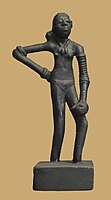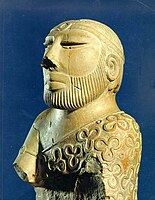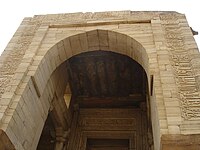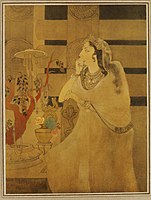Indian art
With Indian art refers to a variety of art forms (especially plastic and painting ) located on the Indian subcontinent have their origin and dissemination. Indian art can be traced back over 5000 years of history. The distribution area of Indian art extends to today's countries India , Pakistan , Bangladesh and the east of Afghanistan .
The art of the early days (up to approx. 300 BC)
Prehistoric India and cave painting
Early finds of Indian art date back to the Stone Age . During excavations in the state of Madhya Pradesh in central India near Bhopal , objects of daily use and art objects were found that are approx. 20,000 years old. In the over 500 small caves and rock overhangs there are numerous rock paintings of animals, human figures and hunting scenes. The archaeological site of Bhimbetka is comparable in its importance to the cave paintings in Spain and France and is a UNESCO World Heritage Site .
Indus culture or Harappa culture
In the 3rd millennium BC An urban civilization of the Bronze Age developed in the Indus region (in today's Pakistan), which is known as the " Indus culture " according to its area of distribution . The Indus culture is comprehensively documented by over 300 excavations. The most important sites are Harappa and Mohenjo-Daro . The Indus culture or Harappa culture, along with Egypt and Mesopotamia, is one of the early advanced cultures of mankind. The works of art found during the excavations in the Indus area include terracotta statuettes of human figures and animals, stone sculptures, bronze statues and seals. In the creation of stone sculptures and bronze statues, the people of the Indus culture achieved considerable artistry.
Dancer from Mohenjo-Daro , bronze, height: 11 cm, approx. 2000 BC u. Z., National Museum of Pakistan, Karachi
Priest -King, Mohenjodaro
Mother Goddess, Harappa Culture, National Museum, New Delhi
Vedic period
- See also: Veda
In the 2nd millennium BC Various migrant peoples migrated through the Indian region, including the Aryans (Aryas) who belong to the Indo-European peoples . The Aryans, who presumably immigrated from the north, brought them from around 1500 BC. The Vedic culture when they mingled with the indigenous tribes. So far, there are no art-historically significant finds from this period.
The end of the Vedic period (6th and 5th centuries BC) was a time of upheaval both politically and religiously. Two religious founders emerged in Magadha : Mahavira founded Jainism, which goes back to ascetic traditions . As Buddha, Siddhartha Gautama taught the "path of the middle", Buddhism, for 40 years .
Maurya
- See also: Maurya Empire
Shortly after the invasion of Alexander the Great (326 BC), Chandragupta laid Maurya around 321 BC. The foundations for the first Indian empire. The most famous art-historical legacy is the Maurya victory columns. They are influenced by Persian, but have their own style due to the shiny polished shaft, the lack of a base and the upturned lotus cup as a capital .
Ashoka's lion pillar in Vaishali , Bihar
Early Buddhist Art
The most important finds of early Buddhist culture date from the time after the Mauryas: important sculptures were found at excavation sites such as Sanchi , Bharhut and Amaravati . There you can also find examples of the Buddhist stupas , a building that symbolizes Buddha himself and his teachings and originally goes back to burial mounds.
While the early Buddhist period did not use images of the Buddha, fully plastic images of the Buddha were created for the first time from the end of the first century of our time, presumably through the influence of Greek culture. The sculptures of the Buddha had a characteristic basic pattern that spread from India to other Buddhist countries: short hair, elongated ears and a loincloth as clothing, a monk's robe thrown over the shoulder and a raincoat draped over the arm. In Greek-influenced representations, artists added a hump of the skull or a topknot, as well as an abundance of folds in the robe.
The Classical Era (300-800 AD)
Gupta Empire
Under the Gupta dynasty , India was politically united from 320 to the 8th century. The Gupta period is considered to be a high point of North Indian art. Although painting was widespread, the works that have come down to us are mostly religious sculptures: stone gods from Hindu art, Buddha figures and Tirthankara figures from Jainism. The two main centers for sculpture were Mathura and Gandhara . Gandhāra is known for the distinctive Gandhāra style in Buddhist art , an aftermath of Graeco-Buddhist syncretism, Indian and Hellenistic influences as well as those of the Persian empires in the centuries after Alexander the Great's conquests of Central Asia around 330 BC. Fused together.
Art theory was systematized under Chandra Gupta II. Vikramaditiya. Guides ( sutra ) were written on painting, sculpture and architecture. During their training, sculptors received z. B. Detailed descriptions of the main parts of the human body and how to represent them. The Buddha statues represented idealized, spiritualized Buddha images.
At the time of the Gupta there was also a renewal of Hinduism: the old scriptures were reread and Buddhism, which had dominated philosophically and intellectually until then, was increasingly faced with competition. Artistically impressive Hindu Gupta temples such as the Dashavatara Temple were built. Nonetheless, Buddhist sites such as Sanchi were also equipped with buildings (temple no. 17) and impressive Buddha images ( stupa no. 1); the Dhamekh stupa in Sarnath was also renewed.
Cave temple
Although there is evidence from the Gupta period that painting was widespread, few examples of painting were known until the 19th century. That changed with the discovery of the rock paintings in the Ajanta Caves in 1819. Although it is not clear whether the monasteries of Ajanta were closely related to the Gupta Empire, they give an impression of Buddhist painting of the classical Indian period. In parallel to the Buddhist cave monasteries like Ajanta, Hindu cave temples were also built, mostly in honor of the god Shiva. The walls of these cave temples are usually decorated with reliefs with mythological motifs, and the entrance area is guarded by huge figures of gods. The most important cave temples include the temples of Elura and the caves on Elephanta Island. The Elephanta Caves are a world heritage site .
The famous figure of the teaching Buddha from Sarnath comes from the Gupta period (5th century)
Vishnu , Dashavatara Temple , Deogarh, 5th century, Gupta period
Colossal Trimurti in the Elephanta Caves
Post-Classical era (approx. 800–1300 AD)
The artistic creation between the Gupta period and the Islamic period is often referred to as the "Middle Ages" in India, which is misleading, however, because the expression suggests that the Indian post-classical epoch is comparable to the European Middle Ages.
During the post-classical epoch, the Indian subcontinent was split up into various domains, but no major power of the time was able to gain dominance over the entire continent. The art of that time was characterized by many regional styles and very varied in its forms.
Hindu renewal
During this period of the rise and fall of Indian regional kingdoms, Hinduism , among other things, was renewed . This renewal movement favored the construction of numerous temples and the creation of many sculptures. So z. B. In the Tamil country under the rule of the Chola, there were sophisticated bronze sculptures such as the depiction of Shiva Nataraja from the 11th or 12th century.
Book illustrations
The oldest known book illustrations in India, the manuscripts of Vajrayana from the 11th century , also date from the time of the Indian "Middle Ages" . Illuminations probably existed before. The illuminations were initially made on birch bark or Palmyra leaves, paper was also known from the 10th century. In Gujarat , which was shaped by Jainism, one can also find book illustrations and paintings on paper, which experienced an upswing due to the increasing incursions of Islamic peoples, because clients wanted to invest in transportable works of art.
Islamic culture in India
Arab and Islamic influence began in India in the early 8th century. In 1206 the Sultanate of Delhi was founded. New mosque buildings in particular can be traced back to this Islamic influence. In addition, precious, monumental tombs such as the mausoleum of Iltutmish (1211–1236) and his son ("Sultan Ghari's grave") from 1231 were built on the Indian subcontinent for the first time . The Indian mausoleums are counted among the most beautiful Islamic monuments in the world. Islamic sculpture is ornamental and characterized by an abundance of geometric flowers, arabesques and calligraphic patterns.
Tomb of Iltutmish , floral ornaments
Early modern and colonial times (approx. 1400–1800)
Mughal art
- See also: Mughal architecture
Between 1526 and 1857, Islamic Mughals ruled northern and central India. This time period represents the high point of Islamic culture on the Indian subcontinent. Well-known examples of Islamic architecture from the time of the Mughal Empire include the Taj Mahal , the Humayun mausoleum and the buildings in the city of Fatehpur Sikri .
Taj Mahal , Agra, India
Humayun's Mausoleum , Delhi, as seen from the entrance portal
Pillar, Diwan-i-Khas, Fatehpur Sikri , India
During the reign of Akbar I and especially under his son Jahangir , Indo-Islamic miniature painting flourished.
Jahangir in Darbar, from Jahangir-nama , c. 1620
Portrait of Shah Jahan , ca.17th century
Court scene in Durbar with the newly crowned ruler Aurangzeb , around 1660
British Colonial Era (1841-1947)
British colonial rule had a major impact on Indian art. For one, the British established art schools such as the Bombay Art Society in major Indian cities in 1888, which increased the influence of Western art. On the other hand, they partially deprived Indian art of its financial basis because, unlike the Indian princes, they were not active as patrons of traditional Indian art.
Employees of the East India Company used modest financial means to create a need for paintings by Indian artists who copied European painting styles and combined them with the techniques of Indian miniature painting. Examples of such a connection between European styles and Indian traditions are Ravi Varma's oil paintings of Indian women dressed in sari. Raja Ravi Varma was the most successful Indian artist of the 19th century. His pictures found recognition both in India and abroad; he won two prizes at the World's Columbian Exhibition in Chicago.
Shakuntala (Raja Ravi Varma) by Raja Ravi Varma , 1870
Asoka's Queen of Abanindranath Tagore , ca.1910
Modern and contemporary art
A turning point in the development of Indian art was initiated by Rabindranath Tagore (1871–1951), who is also referred to as the father of modern Indian art. Together with Nanda Lal Bose he tried to create a national Indian style again. The Bengali School emerged from their efforts. Abanindranath Tagore and Gaganendranath Tagore were important representatives of this direction . Her sister Sunayani Devi , on the other hand, found her own way of expression as an autodidakin, which made recourse to traditional Pattachitra techniques and is sometimes counted as primitivism .
After India gained independence in 1947, the painter Francis Newton Souza founded the Bombay Progressive Art Group. This group tried to incorporate progressiveness and internationalism into their art and rejected the local orientation of previous art as being backwards.
The most famous contemporary Indian painter is Maqbool Fida Husain . Other important Indian painters of the 20th century are Amrita Sher-Gil , Prafulla Dahanukar and Pal Bikash Bhattacharya. In the plastic arts, the Indian artists Anish Kapoor and Dhruva Misty have achieved international renown.
The Sky Mirror by Anish Kapoor in front of the Nottingham Playhous in Nottingham, England
Museums
Many examples of Indian painting can be found in the Jehangir Art Gallery in Mumbai and the National Gallery of Modern Art in New Delhi . The Victoria & Albert Museum in London houses an important collection of Indian art .
See also
literature
- Michel Delahoutre: India: Art and Architecture. Imhof Verlag, Petersburg 2009, ISBN 978-3-86568-438-7 .
- Manfred Görgens: A short history of Indian art. DuMont, Cologne 1986, ISBN 3770115430 .
- Hermann Goetz: India: Five Millennia of Indian Art. 3. Edition. Holle Verlag, Baden-Baden 1979, ISBN 3873551063 .
- Heimo Rau: Style history of Indian art. 2 volumes. Academic Printing and Publishing Company, Graz 1986, ISBN 3-201-01305-6 .
Web links
Individual evidence
- ^ Hermann Goetz: India: Five millennia of Indian art . 3. Edition. Holle-Verlag, Baden-Baden 1979, ISBN 3-87355-106-3 , pp. 5 .
- ↑ Michel Delahoutre: India: Art and Architecture . Imhof Verlag, Petersburg 2009, ISBN 978-3-86568-438-7 , pp. 8-10 .
- ↑ Michel Delahoutre: India: Art and Architecture . Imhof Verlag, Petersburg 2009, ISBN 978-3-86568-438-7 , pp. 11 .
- ↑ Manfred Görgens: A short history of Indian art . DuMont, Cologne 1986, ISBN 3-7701-1543-0 , p. 15 .
- ↑ Michel Delahoutre: India: Art and Architecture . Imhof Verlag, Petersburg 2009, ISBN 978-3-86568-438-7 , pp. 13 .
- ↑ Manfred Görgens: A short history of Indian art . DuMont, Cologne 1986, ISBN 3-7701-1543-0 , p. 28 .
- ↑ Manfred Görgens: A short history of Indian art . DuMont, Cologne 1986, ISBN 3-7701-1543-0 , p. 33 .
- ↑ Michel Delahoutre: India: Art and Architecture . Imhof Verlag, Petersburg 2009, ISBN 978-3-86568-438-7 , pp. 42 .
- ↑ Michel Delahoutre: India: Art and Architecture . Imhof Verlag, Petersburg 2009, ISBN 978-3-86568-438-7 , pp. 32-33 .
- ↑ Heimo Rau: History of Style of Indian Art . tape 1 . Akademische Druck- und Verlagsanstalt, Graz 1986, ISBN 3-201-01305-6 , p. 114-118 .
- ↑ Manfred Görgens: A short history of Indian art . DuMont, Cologne 1986, ISBN 3-7701-1543-0 , p. 87 .
- ↑ Michel Delahoutre: India: Art and Architecture . Imhof Verlag, Petersburg 2009, ISBN 978-3-86568-438-7 , pp. 50 .
- ↑ Manfred Görgens: A short history of Indian art . DuMont, Cologne 1986, ISBN 3-7701-1543-0 , p. 97 .
- ^ Hermann Goetz: India: Five millennia of Indian art . 3. Edition. Holle-Verlag, Baden-Baden 1979, ISBN 3-87355-106-3 , pp. 93 .
- ↑ Heimo Rau: History of Style of Indian Art . tape 1 . Akademische Druck- und Verlagsanstalt, Graz 1986, ISBN 3-201-01305-6 , p. 197 .
- ↑ Manfred Görgens: A short history of Indian art . DuMont, Cologne 1986, ISBN 3-7701-1543-0 , p. 134-135 .
- ↑ Manfred Görgens: A short history of Indian art . DuMont, Cologne 1986, ISBN 3-7701-1543-0 , p. 132-198 .
- ↑ Manfred Görgens: A short history of Indian art . DuMont, Cologne 1986, ISBN 3-7701-1543-0 , p. 197 .
- ↑ Manfred Görgens: A short history of Indian art . DuMont, Cologne 1986, ISBN 3-7701-1543-0 , p. 136 .
- ↑ Manfred Görgens: A short history of Indian art . DuMont, Cologne 1986, ISBN 3-7701-1543-0 , p. 165-166 .
- ↑ Manfred Görgens: A short history of Indian art . DuMont, Cologne 1986, ISBN 3-7701-1543-0 , p. 206 .
- ^ Hermann Goetz: India: Five millennia of Indian art . 3. Edition. Holle-Verlag, Baden-Baden 1979, ISBN 3-87355-106-3 , pp. 193 .
- ^ Hermann Goetz: India: Five millennia of Indian art . 3. Edition. Holle-Verlag, Baden-Baden 1979, ISBN 3-87355-106-3 , pp. 190 .
- ↑ Manfred Görgens: A short history of Indian art . DuMont, Cologne 1986, ISBN 3-7701-1543-0 , p. 230, 232, 237 .
- ↑ Manfred Görgens: A short history of Indian art . DuMont, Cologne 1986, ISBN 3-7701-1543-0 , p. 240 .
- ↑ Manfred Görgens: A short history of Indian art . DuMont, Cologne 1986, ISBN 3-7701-1543-0 , p. 259 .
- ↑ Manfred Görgens: A short history of Indian art . DuMont, Cologne 1986, ISBN 3-7701-1543-0 , p. 260 .
- ↑ Clare Harris: Other centers of modernity: India . In: Martin Kemp (Ed.): DuMont History of Art . DuMont, Cologne 2003, ISBN 3-8321-7301-3 , p. 478 .
- ^ Hermann Goetz: India: Five millennia of Indian art . 3. Edition. Holle-Verlag, Baden-Baden 1979, ISBN 3-87355-106-3 , pp. 228-230 .
- ↑ Partha Mitter: The Triumph of Modernism: India's Artists and the Avant-garde, 1922-47 . Reaction Books, 2007, ISBN 978-1-86189-318-5 , pp. 36-45 .
- ↑ Clare Harris: Other centers of modernity: India . In: Martin Kemp (Ed.): DuMont History of Art . DuMont, Cologne 2003, ISBN 3-8321-7301-3 , p. 478 .
- ↑ Clare Harris: Other centers of modernity: India . In: Martin Kemp (Ed.): DuMont History of Art . DuMont, Cologne 2003, ISBN 3-8321-7301-3 , p. 479-481 .






































